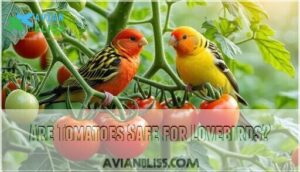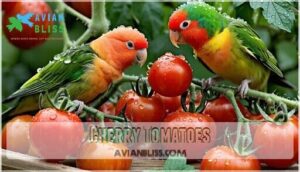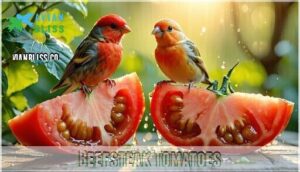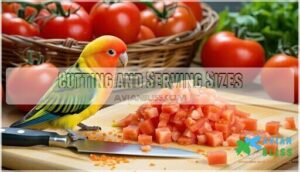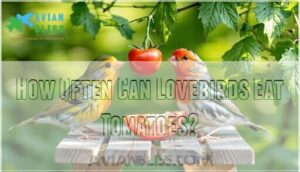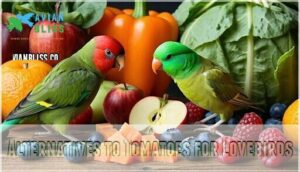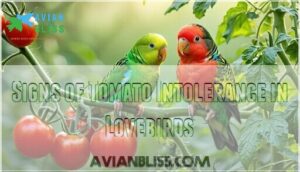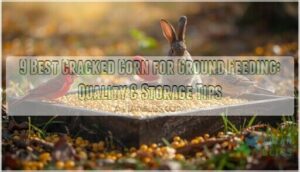This site is supported by our readers. We may earn a commission, at no cost to you, if you purchase through links.

Think of tomatoes as the occasional dessert rather than a main course—they’re acidic and can upset your bird’s stomach if given too frequently.
Skip the green parts entirely since they contain toxic compounds that’ll make your feathered friend sick.
Wash thoroughly, remove seeds, and cut into tiny pieces your lovebird can easily handle. Cherry tomatoes work great since they’re naturally bite-sized.
While tomatoes offer vitamin C and antioxidants, they shouldn’t replace your bird’s regular diet. The secret lies in knowing exactly how much and how often to serve them safely.
Table Of Contents
- Key Takeaways
- Tomatoes and Lovebirds: an Overview
- Are Tomatoes Safe for Lovebirds?
- Types of Tomatoes Suitable for Lovebirds
- Preparing Tomatoes for Lovebirds
- How Often Can Lovebirds Eat Tomatoes?
- Potential Health Benefits of Tomatoes for Lovebirds
- Risks of Feeding Tomatoes to Lovebirds
- Alternatives to Tomatoes for Lovebirds
- Signs of Tomato Intolerance in Lovebirds
- Balancing Tomatoes in a Lovebird’s Diet
- Frequently Asked Questions (FAQs)
- Conclusion
Key Takeaways
- You can feed your lovebird tomatoes, but only ripe, red ones in small portions – limit to about 1/4 teaspoon once or twice weekly as an occasional treat, not a dietary staple.
- Always remove seeds, stems, and green parts before serving – these contain toxic compounds that will make your bird sick, and wash thoroughly to eliminate pesticide residues.
- Watch for signs of digestive upset or behavioral changes – tomatoes’ high acidity can cause stomach irritation, diarrhea, or lethargy in sensitive birds.
- Balance tomatoes with safer alternatives like apples, carrots, and bell peppers – these provide better nutrition without the acidity concerns while maintaining dietary variety.
Tomatoes and Lovebirds: an Overview
If you’re wondering whether your lovebird can enjoy tomatoes as a treat, you’re asking the right question.
While tomatoes aren’t toxic to lovebirds, they require careful preparation and should only be offered occasionally due to their high acidity levels.
Tomatoes are treats, not staples – proper prep prevents problems for your feathered friend.
Nutritional Value of Tomatoes
Tomatoes offer impressive vitamin content for lovebirds, delivering vitamin C for immune support and vitamin A for healthy vision.
Their mineral composition includes potassium and calcium for strong bones. Lycopene benefits include powerful antioxidant protection against cellular damage.
As a natural hydration source and fiber source, tomatoes support digestion. However, lovebird nutritional needs require moderation due to acidity levels.
These colorful nutrients make tomatoes a worthy occasional treat when can birds eat tomatoes safely with proper preparation for tomatoes for lovebirds. They’re also a part of the nightshade family.
Lovebird Dietary Needs
Understanding your lovebird’s nutritional needs helps you make informed feeding choices.
These colorful companions require a balanced diet that prioritizes their health and vitality. A balanced diet is essential for their overall well-being.
- Pellet Importance: High-quality pellets should comprise 75-80% of your lovebird’s daily intake, providing essential nutrients and balanced nutrition.
- Fresh Foods: Vegetables and limited fruits, including safe foods for lovebirds like tomatoes, make up 20-25% of their lovebird diet.
- Seed Variety: Use seeds only as occasional treats to prevent obesity and nutritional imbalances in your bird’s routine.
- Hydration Sources: Fresh water must be available daily, supporting your lovebird’s nutritional needs alongside their regular food intake.
Are Tomatoes Safe for Lovebirds?
You’re right to wonder about tomato safety for your lovebird – these colorful fruits can be part of their diet, but they come with important considerations.
While tomatoes offer valuable nutrients like vitamins A and C, their natural acidity and potential toxins require careful handling and moderation, making moderation key to their safe inclusion.
Potential Benefits
When offered sparingly, tomatoes can provide your lovebird with valuable health benefits for their overall well-being.
Sparingly offered tomatoes deliver valuable vitamins and health benefits for your feathered friend’s wellbeing.
These colorful fruits deliver essential Vitamin Intake** through vitamins A, C, and K, supporting immune function and vision.
The Mineral Boost from potassium and calcium helps maintain healthy bones and blood pressure.
Tomatoes’ Antioxidant Power fights harmful free radicals, while serving as a natural Hydration Source.
Their Fiber Content aids digestion when included properly in your lovebird diet.
A balanced diet requires essential vitamins and minerals for peak health.
Possible Risks
While tomatoes can benefit your lovebird, several risks deserve your attention.
High acidity levels can trigger stomach issues and digestive upset in sensitive birds.
Here’s what to watch for:
- Solanine toxicity: Green parts contain compounds that cause weakness and confusion
- Pesticide exposure: Chemical residues may accumulate and harm your bird’s health
- Allergic reactions: Some lovebirds develop diarrhea or behavioral changes after eating tomatoes
Monitor closely when introducing any toxic foods to prevent serious complications.
Types of Tomatoes Suitable for Lovebirds
When choosing tomatoes for your lovebird, you’ll find that not all varieties are created equal regarding safety and acidity levels.
Cherry tomatoes tend to be more acidic due to their skin-to-flesh ratio, while Roma and beefsteak tomatoes offer better options with lower acidity and easier seed removal.
Cherry Tomatoes
Cherry tomatoes make perfect bite-sized treats for your feathered friends.
Their small size simplifies portioning advice, letting you offer manageable pieces without worry.
Choose organic cherry varieties to minimize pesticide exposure, and always wash thoroughly before serving.
These colorful gems pack vitamins while maintaining lower acidity levels than larger varieties.
Remember seed removal and check skin safety by peeling if your lovebird shows sensitivity.
Cherry tomatoes for lovebirds work best as occasional treats, not daily staples.
Tomatoes should complement, never dominate, your bird’s balanced diet for peak health.
Roma Tomatoes
When selecting Roma tomatoes for your lovebirds, you’re choosing a variety with dense, meaty flesh and lower acidity than other types.
Their reduced water content makes them less messy while providing essential Roma nutrients like fiber and vitamins.
- Roma Preparation: Remove all seeds, stems, and skin before serving to prevent choking hazards
- Roma Acidity: Less acidic than cherry varieties, making them gentler on sensitive digestive systems
- Cooking Roma: Lightly cooking reduces acidity further and aids digestion for tomatoes for lovebirds
- Roma vs Others: Dense texture means less juice and waste compared to beefsteak varieties
- Roma Nutrients: Rich in lycopene, vitamin C, and potassium that support your lovebird’s health
Beefsteak Tomatoes
While Roma tomatoes work well for their dense texture, beefsteak tomatoes offer even more versatility for your feathered companion.
These large, juicy varieties provide ample flesh perfect for removing seeds and stems safely.
| Aspect | Beefsteak Advantage | Important Notes |
|---|---|---|
| Size | Easy seed removal | Cut into small pieces |
| Preparation | More flesh to work with | Always wash thoroughly |
| Acidity | Lower when cooked | Serve cooked for sensitive birds |
| Benefits | Rich in lycopene | Limit to occasional treats |
Organic beefsteak tomatoes minimize pesticide exposure, making them safer for your lovebird’s delicate system.
Preparing Tomatoes for Lovebirds
Proper preparation guarantees your lovebird can safely enjoy tomatoes while minimizing health risks. You’ll need to wash thoroughly and cut correctly to remove potential hazards like pesticides and choking risks.
Washing and Cleaning
Clean preparation starts with choosing organic tomatoes for lovebirds to minimize pesticide exposure.
Proper washing guarantees your feathered friend stays healthy and happy.
Follow these steps for thorough cleaning:
- Rinse under cool running water while gently rubbing the skin to remove surface contaminants
- Use produce wash or diluted vinegar solution for enhanced residue removal from non-organic tomatoes
- Pat dry with clean paper towels using gentle dabbing motions to avoid bruising
- Inspect for blemishes or soft spots that could harbor harmful bacteria
- Store washed tomatoes separately in covered containers to prevent cross-contamination
The washing frequency should match your feeding schedule—clean tomatoes right before serving for maximum freshness.
Consider using a specialized tomato cleaner for ideal results.
Safe cleaners like commercial produce washes work well, but plain water removes most surface residues effectively.
These drying methods preserve the tomato’s texture while guaranteeing your lovebird receives clean, safe food.
Cutting and Serving Sizes
When cutting tomatoes for lovebirds, create bite-size pieces about 1/4 inch to prevent choking.
Always remove seeds to avoid potential risks from solanine toxicity, and consider skin peeling for easier digestion.
This careful preparation reduces acidity concerns while maintaining proper serving size.
Some owners may even use a specialized cutting tool for precise preparation.
Remember portion control – limit serving frequency to once or twice weekly for safe tomato consumption.
How Often Can Lovebirds Eat Tomatoes?
When determining how often your lovebird can enjoy tomatoes, moderation is absolutely essential for their health and safety.
You should offer tomatoes as an occasional treat only once or twice per week, limiting portions to about a quarter teaspoon to prevent digestive upset from the fruit’s natural acidity, which is crucial for preventing digestive upset.
Recommended Frequency
After proper preparation, weekly limit becomes your next consideration.
Offer tomatoes as an occasional treat no more than once or twice weekly. This treat frequency prevents acidity overload while letting your lovebirds enjoy the benefits.
As part of a balanced diet, seeds offer key nutrients for your lovebird.
Monitor response after each serving—watch for digestive upset or behavioral changes. If you notice any concerning symptoms, reduce frequency further or seek vet consultation.
Remember, moderation keeps your lovebirds diet balanced and healthy.
Portion Control
When offering tomatoes to your lovebird, proper portion control becomes essential for maintaining their health.
Think of tomatoes as special treats – a small indulgence that shouldn’t overshadow their main diet.
The ideal serving size is roughly ¼ teaspoon per feeding, which might seem tiny but it’s perfectly adequate for your feathered friend.
This cautious approach prevents acidity-related digestive upset while still allowing your lovebird to enjoy the nutritional benefits.
- Start small: Begin with even smaller portions to test your bird’s tolerance
- Monitor closely: Watch for any signs of digestive discomfort or behavioral changes
- Balance wisely: Pair tomato treats with low-acid fruits to maintain dietary harmony
Remember that weight management matters substantially for lovebirds.
Their small bodies can’t handle excess calories from sugary treats like tomatoes.
Maintaining proper treat frequency and acidity balance guarantees your pet’s long-term wellness while keeping mealtime interesting.
Potential Health Benefits of Tomatoes for Lovebirds
While tomatoes aren’t essential for lovebirds, they do offer some nutritional perks when served correctly.
You’ll find that these colorful treats pack vitamins and antioxidants that can support your feathered friend’s health in small doses, with antioxidants being a key factor.
Vitamins and Minerals
Your lovebird’s health gets a boost from tomatoes’ impressive nutrient profile.
These vibrant fruits deliver Vitamin A for sharp vision and Vitamin C for immune support.
They’re also a reliable Potassium Source for heart health.
| Nutrient | Lovebird Benefit |
|---|---|
| Vitamin A | Supports healthy vision and feather quality |
| Vitamin C | Boosts immune system function |
| Potassium | Maintains proper heart rhythm |
| Calcium Content | Strengthens bones and egg production |
| Folate (B9) | Aids in cell division and growth |
Remember, moderation keeps your feathered friend thriving with lovebird safe food choices.
Antioxidants
Beyond their vibrant color, tomatoes pack powerful antioxidants that boost your lovebird’s immune system support and cellular health.
Lycopene benefits include free radical defense, while these compounds help in reducing inflammation throughout your bird’s body.
Change with fruits, apples, berries, or vegetable options like carrots to maintain balance.
Choose organic tomatoes for safe, health benefits without pesticide concerns.
Risks of Feeding Tomatoes to Lovebirds
While tomatoes can be a tasty treat for your lovebird, they come with some important risks you’ll need to bear in mind.
The high acidity and potential pesticide residues make careful preparation and moderation essential for your feathered friend’s safety.
Acidity Concerns
While tomatoes offer some nutritional benefits, their high acidity poses real concerns for your lovebird’s health.
With a tomato pH ranging from 3.5 to 4.9, these fruits can cause significant digestive discomfort and create ulcer risk in your bird’s delicate system.
Acidity effects you’ll want to watch for include:
- Stomach irritation leading to vomiting or abnormal droppings
- Mouth and throat ulcers from repeated exposure to harsh acids
Cooking effects can help reduce acidity levels, making cooked tomatoes slightly safer than raw ones.
However, safe alternatives like carrots or bell peppers provide better nutrition without the tomato toxicity birds face from excessive acid consumption.
Pesticide Residues
Before feeding tomatoes to your feathered friend, consider the pesticide residues lurking on conventionally grown produce.
Organic tomatoes offer the safest option, eliminating harmful chemical exposure that can threaten bird food safety.
When organic isn’t available, thorough washing methods become essential—scrub under running water to remove surface contaminants.
Safe sourcing from trusted suppliers reduces toxin exposure risks.
Remember, your lovebird’s delicate system can’t handle the same chemical loads as humans, making careful selection of safe foods essential for their wellbeing.
Alternatives to Tomatoes for Lovebirds
While tomatoes can be a treat for your lovebird, you’ll want to explore safer alternatives that offer better nutrition without the acidity concerns.
Fruits like apples, berries, and melons provide essential vitamins with lower acid content, while vegetables such as carrots, bell peppers, and leafy greens deliver nutrients your bird needs for peak health.
Other Safe Fruits
In the context of safe fruits for your feathered friend, you’ll find plenty of delicious Apple Options beyond tomatoes.
Berry Benefits include antioxidants from blueberries and strawberries, while Melon Variety offers hydrating watermelon and cantaloupe.
You can even explore trading these options for potential profit.
Practice Fruit Rotation weekly, but avoid Citrus Concerns like oranges.
These fruits for lovebirds provide essential nutrients without tomato risks, supporting healthy lovebird diet tips.
Vegetable Options
When choosing vegetables for lovebirds, prioritize variety and nutrition over convenience.
Here are five excellent vegetable options that’ll keep your feathered friend thriving:
- Leafy Greens – Spinach, kale, and romaine provide essential vitamins
- Bell Peppers – Colorful, vitamin C-rich, and naturally sweet
- Root Vegetables – Carrots and sweet potatoes offer beta-carotene
- Cruciferous Veggies – Broccoli florets pack nutritional punch
- Sprouted Seeds – Fresh sprouts deliver concentrated nutrients
These safe vegetables create a balanced lovebird diet beyond tomatoes.
Signs of Tomato Intolerance in Lovebirds
While tomatoes can be a healthy treat for lovebirds when given properly, it’s vital to watch for signs that your bird isn’t tolerating them well.
You’ll need to monitor your lovebird closely after introducing tomatoes, as some birds may experience digestive upset or show behavioral changes that indicate the acidic fruit doesn’t agree with their system, and this requires careful observation to ensure the bird’s health and well-being, particularly in relation to behavioral changes.
Digestive Issues
After feeding tomatoes to your lovebird, watch closely for digestive issues that signal intolerance.
Diarrhea or vomiting often appears within hours, indicating your bird’s system can’t handle the acidity.
Check droppings for unusual consistency or color changes.
Some birds develop stomach pain from tomato acidity effects, while others show signs of ulcer risk through blood-tinged vomit.
Monitor eating habits too—decreased appetite usually means digestive upset.
If gut health seems compromised, remove tomatoes immediately and consult your avian vet for proper diarrhea signs assessment.
Behavioral Changes
Observing your lovebird’s behavior after feeding tomatoes reveals important clues about their tolerance.
When acidity causes digestive upset, you’ll notice distinct behavioral changes that signal discomfort.
Watch for these key behavioral shifts:
- Lethargy signs – decreased activity, excessive sleeping, or reluctance to play
- Appetite changes – avoiding food, refusing treats, or changes in eating patterns
- Feather plucking – increased preening, self-destructive behaviors, or restlessness
Vocalization shifts like increased irritability or distress calls often accompany these symptoms.
Understanding sudden behavior changes can help owners identify potential health problems early on.
Your bird’s social interaction may also decrease as they cope with internal discomfort from tomatoes’ natural acidity.
Balancing Tomatoes in a Lovebird’s Diet
You don’t want tomatoes to take over your bird’s plate, but they can play a supporting role in a well-rounded diet.
When you pair tomatoes with complementary foods like leafy greens, safe fruits, and quality pellets, you’ll create the variety your lovebird needs to stay healthy and happy.
Complementary Foods
Tomatoes work best when paired with safe foods for birds that round out your lovebird’s nutrition.
Balance them with Seed Variety like millet and sunflower seeds, plus high-quality Pellet Choices that form your bird’s dietary foundation.
Add Sprout Benefits through fresh alfalfa or mung bean sprouts for extra vitamins.
Mineral Blocks provide essential calcium, while Treat Diversity includes apples, carrots, and bell peppers.
This lovebird diet plan guarantees tomatoes complement rather than dominate your lovebird care routine, creating a well-rounded lovebird food list.
Dietary Variety
A well-rounded lovebird diet plan keeps your feathered friend happy and healthy.
Beyond complementary foods, mixing up your bird’s meals prevents boredom while meeting nutritional needs. Proper lovebird care involves strategic treat rotation and foraging enrichment opportunities.
Consider this feeding lovebirds approach for dietary variety:
- Seed Variety: Rotate 4-5 different seed types daily from your lovebird food list
- Pellet Choices: Switch between 2-3 quality brands monthly for balanced nutrition
- Sprout Benefits: Introduce fresh sprouts weekly alongside new fruits and vegetables
- Foraging Enrichment: Hide treats in toys or paper cups to stimulate natural behaviors
This variety keeps meals interesting while supporting peak health.
Frequently Asked Questions (FAQs)
Can a Lovebird eat tomato?
Yes, lovebirds can eat tomatoes, but you’ll want to offer them sparingly.
Remove the seeds and skin first, then serve small pieces just once or twice weekly as an occasional treat.
What food can a Lovebird eat?
You can feed your lovebird a mix of seeds, pellets, leafy greens, carrots, bell peppers, apples, and berries.
Just skip avocado and chocolate—those are trouble!
Variety keeps your feathered friend happy and healthy.
Can lovebirds eat fruit?
Around 80% of a lovebird’s diet should consist of pellets, but you can absolutely offer fruit as healthy treats.
Fresh fruits like apples, berries, and melons provide vitamins and variety to keep your feathered friend happy and healthy, with pellets being the main staple.
Can lovebirds eat seeds?
Seeds are essential for your lovebird’s diet and should make up about 50-70% of their daily intake.
You’ll want high-quality seed mixes containing millet, sunflower seeds, and safflower seeds for ideal nutrition.
Can lovebirds eat cucumbers?
Lovebirds can safely eat cucumbers! They’re actually one of the best vegetable choices for your feathered friend.
Cucumbers are low in acidity, high in water content for hydration, and won’t cause digestive upset if your bird gets a little greedy, making them a great choice for hydration.
Can lovebirds eat lettuce?
Yes, you can feed your lovebird lettuce! Iceberg lettuce offers little nutrition, but romaine and leafy greens are better choices. Wash thoroughly and offer small pieces occasionally as treats.
Can a lovebird eat tomatoes?
Like a forbidden fruit in your feathered friend’s garden, tomatoes tempt but require caution.
Yes, lovebirds can eat tomatoes, but only in tiny portions—a quarter slice maximum—once weekly.
Remove seeds and skin first to prevent digestive upset from acidity.
Can lovebirds eat raw vegetables?
Most raw vegetables are safe and healthy for lovebirds when properly prepared.
Fresh options like carrots, bell peppers, leafy greens, and broccoli provide essential nutrients.
Always wash thoroughly, remove seeds from unsafe varieties, and introduce new foods gradually to monitor reactions.
What fruits can lovebirds not eat?
Picture a colorful fruit bowl that’s secretly a minefield – not every bright piece belongs in your lovebird’s beak.
You’ll want to avoid avocado, chocolate, citrus fruits, grapes, cherries, and any fruit pits or seeds that contain toxins, including those from cherries.
What vegetables can lovebirds not eat?
Lovebirds can’t eat avocado, onions, garlic, mushrooms, chocolate, caffeine, or nightshade vegetables like tomato leaves and stems.
You’ll want to avoid anything toxic or acidic that might harm their delicate digestive systems.
Conclusion
Remember, moderation is key when feeding your lovebird tomatoes.
Can lovebirds eat tomatoes? Absolutely, but treat them as occasional treats rather than dietary staples.
Stick to ripe, red varieties in small portions, wash thoroughly, and remove all seeds.
Watch for digestive upset or behavioral changes after introducing tomatoes.
Balance is essential—complement tomatoes with other safe fruits and vegetables while maintaining your bird’s primary diet.
With proper preparation and portion control, you’ll keep your feathered friend happy and healthy, ensuring a healthy lifestyle.
- https://www.parrotforums.com/threads/tomatoes-whats-the-real-deal.47920/
- https://zupreem.com/what-are-the-best-veggies-for-birds/
- https://www.chewy.com/education/bird/food-and-nutrition/can-birds-eat-tomatoes
- https://sustainability-success.com/do-birds-eat-tomatoes/
- https://aviancontrolinc.com/do-birds-eat-tomatoes/

